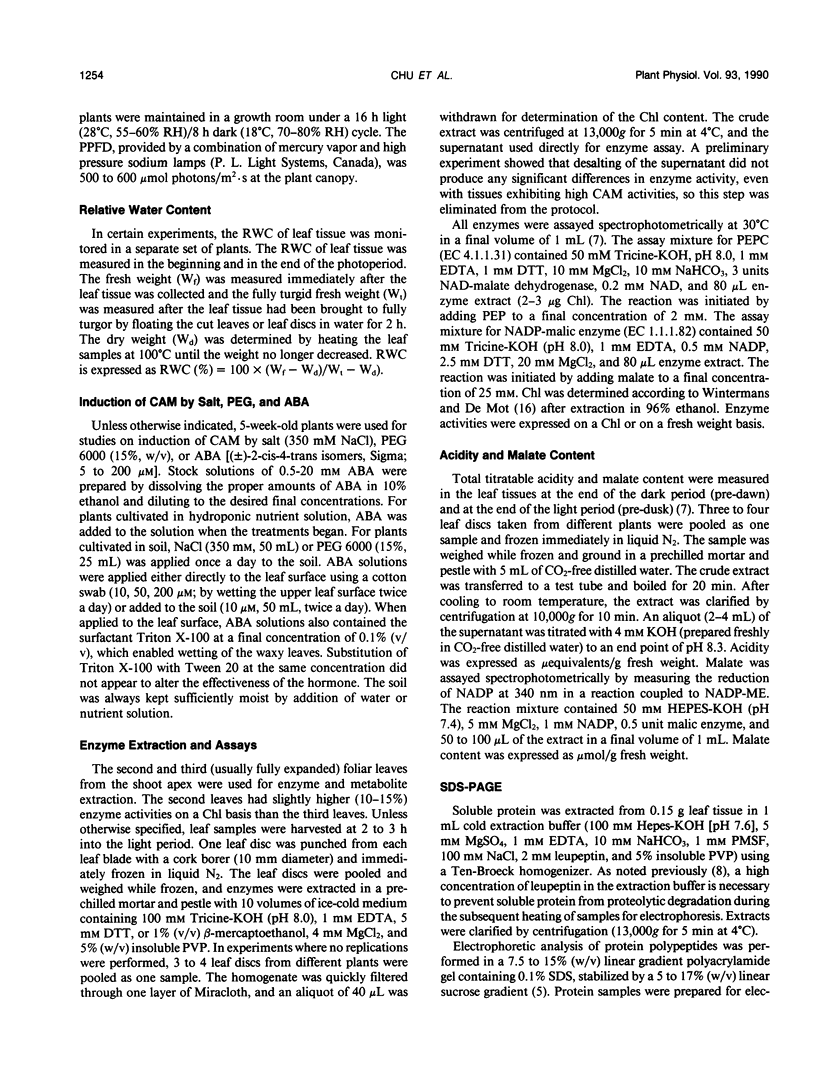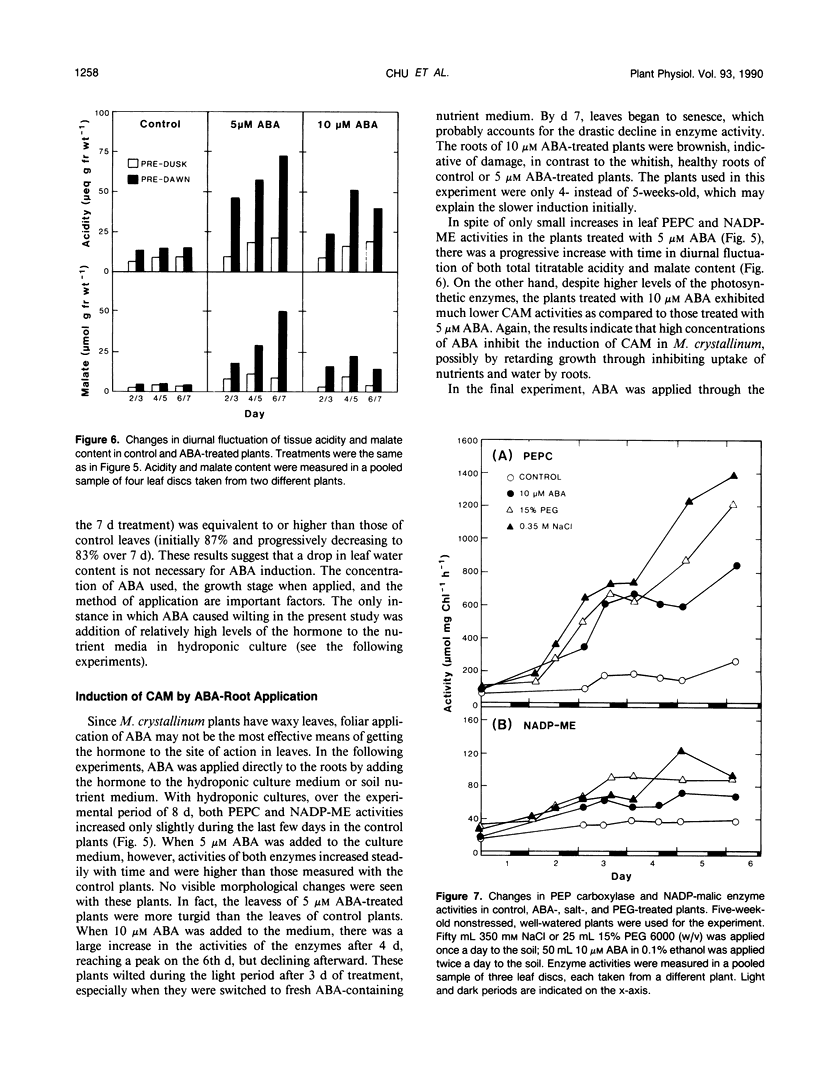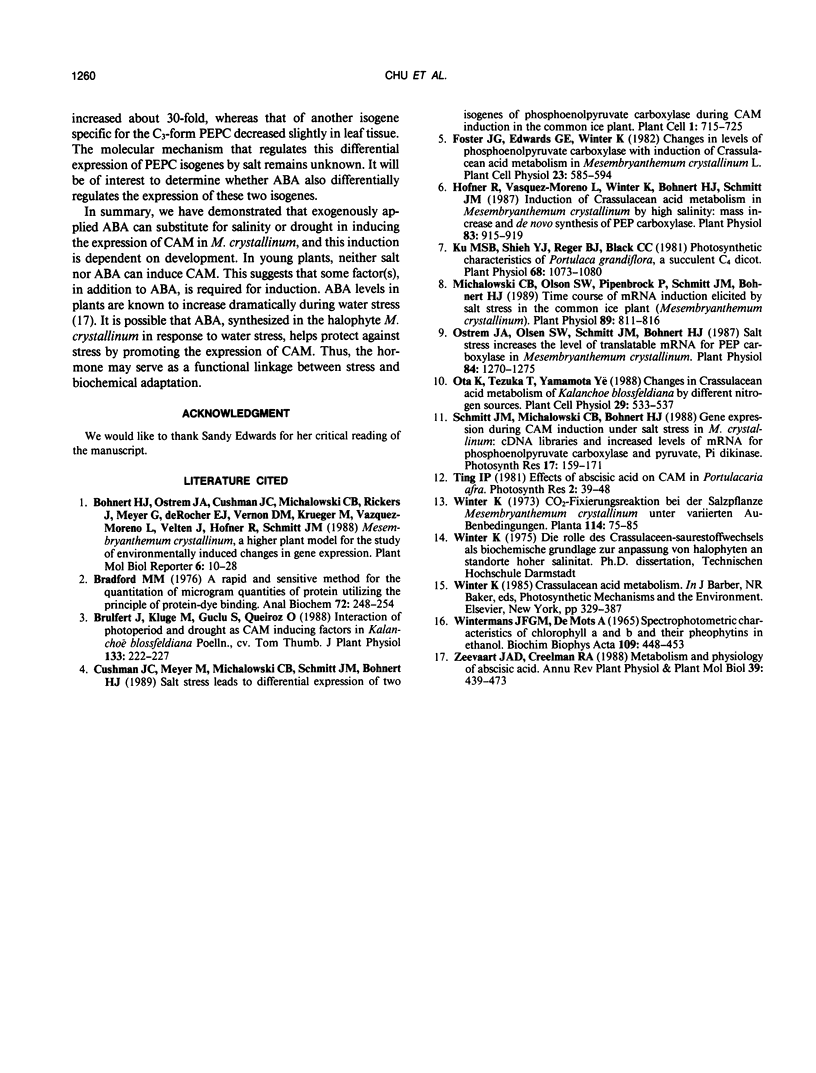Abstract
The facultative halophyte, Mesembryanthemum crystallinum, shifts its mode of carbon assimilation from the C3 pathway to Crassulacean acid metabolism (CAM) in response to water stress. In this study, exogenously applied abscisic acid (ABA), at micromolar concentrations, could partially substitute for water stress in induction of CAM in this species. ABA at concentrations of 5 to 10 micromolar, when applied to leaves or to the roots in hydroponic culture or in soil, induced the expression of CAM within days (as indicated by the nocturnal accumulation of total titratable acidity and malate). After applying ABA there was also an increase in phosphoenolpyruvate carboxylase and NADP-malic enzyme activities. The degree and time course of induction by ABA were comparable to those induced by salt and water stress. Electrophoretic analyses of leaf soluble protein indicate that the increases in phosphoenolpyruvate carboxylase activity during the induction by ABA, salt, and water stress are due to an increase in the quantity of the enzyme protein. ABA may be a factor in the stress-induced expression of CAM in M. crystallinum, serving as a functional link between stress and biochemical adaptation.
Full text
PDF







Images in this article
Selected References
These references are in PubMed. This may not be the complete list of references from this article.
- Bradford M. M. A rapid and sensitive method for the quantitation of microgram quantities of protein utilizing the principle of protein-dye binding. Anal Biochem. 1976 May 7;72:248–254. doi: 10.1006/abio.1976.9999. [DOI] [PubMed] [Google Scholar]
- Cushman J. C., Meyer G., Michalowski C. B., Schmitt J. M., Bohnert H. J. Salt stress leads to differential expression of two isogenes of phosphoenolpyruvate carboxylase during Crassulacean acid metabolism induction in the common ice plant. Plant Cell. 1989 Jul;1(7):715–725. doi: 10.1105/tpc.1.7.715. [DOI] [PMC free article] [PubMed] [Google Scholar]
- Höfner R., Vazquez-Moreno L., Winter K., Bohnert H. J., Schmitt J. M. Induction of Crassulacean Acid Metabolism in Mesembryanthemum crystallinum by High Salinity: Mass Increase and de Novo Synthesis of PEP-Carboxylase. Plant Physiol. 1987 Apr;83(4):915–919. doi: 10.1104/pp.83.4.915. [DOI] [PMC free article] [PubMed] [Google Scholar]
- Ku S. B., Shieh Y. J., Reger B. J., Black C. C. Photosynthetic Characteristics of Portulaca grandiflora, a Succulent C(4) Dicot : CELLULAR COMPARTMENTATION OF ENZYMES AND ACID METABOLISM. Plant Physiol. 1981 Nov;68(5):1073–1080. doi: 10.1104/pp.68.5.1073. [DOI] [PMC free article] [PubMed] [Google Scholar]
- Michalowski C. B., Olson S. W., Piepenbrock M., Schmitt J. M., Bohnert H. J. Time Course of mRNA Induction Elicited by Salt Stress in the Common Ice Plant (Mesembryanthemum crystallinum). Plant Physiol. 1989 Mar;89(3):811–816. doi: 10.1104/pp.89.3.811. [DOI] [PMC free article] [PubMed] [Google Scholar]
- Ostrem J. A., Olson S. W., Schmitt J. M., Bohnert H. J. Salt Stress Increases the Level of Translatable mRNA for Phosphoenolpyruvate Carboxylase in Mesembryanthemum crystallinum. Plant Physiol. 1987 Aug;84(4):1270–1275. doi: 10.1104/pp.84.4.1270. [DOI] [PMC free article] [PubMed] [Google Scholar]
- Wintermans J. F., de Mots A. Spectrophotometric characteristics of chlorophylls a and b and their pheophytins in ethanol. Biochim Biophys Acta. 1965 Nov 29;109(2):448–453. doi: 10.1016/0926-6585(65)90170-6. [DOI] [PubMed] [Google Scholar]



